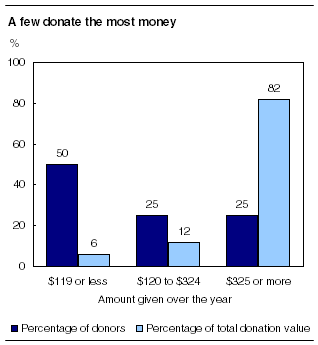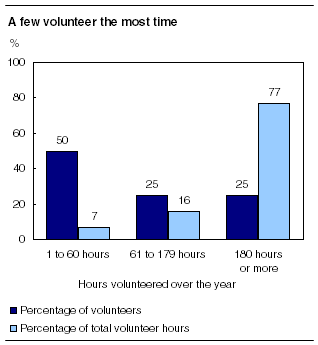
















 |
|
 |                |
Information identified as archived is provided for reference, research or recordkeeping purposes. It is not subject to the Government of Canada Web Standards and has not been altered or updated since it was archived. Please "contact us" to request a format other than those available.

|

Monday, June 5, 2006 Canada Survey of Giving, Volunteering and Participating
Canadians are extremely generous with the money and time they give to charitable and other nonprofit organizations. But it is a relatively small proportion of the population that provides the bulk of the help, according to the latest survey on giving and volunteering. Although many Canadians give money, charitable and other nonprofit organizations rely on a relatively small group of donors for the majority of their support. The top one-quarter of donors (21% of Canadians) who gave $325 or more during 2004 provided 82% of the value of all donations, the survey showed. 
These top donors tended to be older, to have higher levels of household income, and to have higher levels of formal education. People who are employed or widowed, or attend religious services on a weekly basis, also tended to be in this top group of donors.
Charitable and other nonprofit organizations also depend heavily on a relatively small group of volunteers for unpaid help. In 2004, the top one-quarter of volunteers (11% of Canadians) who contributed 180 hours or more accounted for 77% of total volunteer hours. These top volunteers were broadly distributed throughout the population. However, those who attend religious services on a weekly basis and those who have university degrees were much more likely than others to be top volunteers. 
Nationally, more than 22 million Canadians — 85% of the population aged 15 and over — made a financial donation to a charitable or other nonprofit organization during the 12-month period covered by the survey. They donated an estimated $8.9 billion, an average of $400 each. During the same one-year period, nearly 12 million Canadians, or 45% of the population aged 15 and over, did some volunteering through a group or organization. Their contributions totalled almost 2 billion hours, which was equivalent to one million full-time jobs. On average, volunteers contributed 168 hours each. Rates of donating and volunteering in 2004 are higher than those found in two similar surveys in 1997 and 2000. However, the results cannot be compared because the 2004 survey used a somewhat different questionnaire than the earlier two, as well as a different survey design. Charitable giving: Religious organizations largest beneficiariesReligious organizations got the highest proportion of total donations in 2004, about 45%, or nearly $4.0 billion. Donors to religious organizations made the largest average donations, about $395. Health organizations were second, receiving more than $1.2 billion, or 14% of the total. Although religious organizations were given more money than other organizations, other organizations have a wider base of support in the population. Almost 6 out of 10 Canadians (57%) made donations to health organizations, 43% donated to social services organizations, and 38% donated to religious organizations. Volunteering: Nearly one fifth of hours directed to sports and recreationMost volunteering was directed towards four types of organizations in 2004. About 11% of Canadians devoted their time to each of sports and recreation; social services; and education and research organizations. About 1 in 10 gave their time to religious organizations. In terms of the number of hours contributed, 18% of all volunteer hours were contributed to sports and recreation and 17% to social services organizations. About 16% went to religious organizations and 11% to education and research organizations. Youth had the highest rate of volunteeringThe percentage of Canadians who volunteer generally decreases with age. Over half (55%) of all young people aged 15 to 24 volunteered through a group or organization, compared to one-third (32%) of seniors aged 65 and older. It is important to note, however, that older volunteers tend to give more time. The average number of hours volunteered generally rises with age, from 139 hours for youth volunteers to a high of 245 hours for senior volunteers. People who attended religious services weekly were also more likely to volunteer their time. About 62% of them did so, compared with only 43% of individuals who did not attend services on a weekly basis. Through the course of the year, they also tended to volunteer more time on average, 229 hours compared with 147 hours for those who did not attend services weekly. It is worth noting that those who attended services weekly volunteered more than half (57%) of their hours to non-religious causes. Provinces: High donor rates in Atlantic CanadaFive provinces had donor rates higher than the national average of 85%: Newfoundland and Labrador, where 93% of the population aged 15 and over made donations; Prince Edward Island (93%), Nova Scotia (90%), Ontario (90%) and New Brunswick (88%). The remaining provinces and all of the territories had rates lower than the national average. The lowest was 63% in Nunavut. There was a different pattern for average donations. They ranged from a high of $500 in Alberta to a low of $176 in Quebec. All four Atlantic provinces had a higher percentage of donors than the national rate. However, the average annual amount in these provinces was lower than the national average ($400). Average donations for all provinces west of Quebec exceeded the national average. In terms of volunteering through a group or organization, Saskatchewan had the highest volunteer rate (54%), followed by the Northwest Territories (53%), and the Yukon (52%). The lowest, 34%, was in Quebec. With respect to hours per year, volunteers in British Columbia contributed an average of 199 hours, the highest, followed by volunteers in the Yukon (196) and Nova Scotia (195). Volunteers reported the fewest hours in Nunavut (132) and Quebec (146).
More than 8 in 10 Canadians helped others directlyCanadians provide substantial help to others directly, without a formal organization or group being involved. More than 8 in 10 (83%) reported that they had helped others directly in the previous year. This does not include help given to individuals living in the same household. About 60% provided help at an individual's home, the most common activity, while 50% provided health-related or personal care, including unpaid babysitting or visiting an elderly person. Participation: Two-thirds of the population belonged to a group, organization or associationThe third component of the survey asked questions about other forms of involvement in society. Respondents were asked whether they belonged to a variety of community organizations and groups, as well as about the extent to which they attended meetings, social functions or other activities. Two-thirds (66%) of Canadians aged 15 and over were members of, or participants in, at least one community organization, such as a community association, service club or union. They belonged to four main types of organizations: sports and recreation; professional associations and unions; religious organizations or groups; and cultural, education or hobby organizations. Participation rates were highest in Saskatchewan, Prince Edward Island and Ontario, and lowest in Quebec and Newfoundland and Labrador. Definitions, data sources and methods: survey number 4430. The publication Caring Canadians, Involved Canadians: Highlights from the Canada Survey of Giving, Volunteering and Participating, 2004 (71-542-XIE, free) is now available online from the Our products and services page of our website. A paper version of the publication (71-542-XPE, $20) is also available. Data from the 2004 Follow-up Survey of Giving, Volunteering and Participating are also now available. For more information about the analysis contained in this release, contact Lisa Hartford (416-597-2293, ext. 225), Imagine Canada. For information on the concepts, methods or data quality of this release, contact Client Services (1-800-461-9050; 613-951-3321; fax: 613-951-4527; ssd@statcan.gc.ca), Special Surveys Division. | ||||||||||||||||||||||||||||||||||||||||||||||||||||||||||||||||||||||||||||||||||||||||||||||
|
|
|